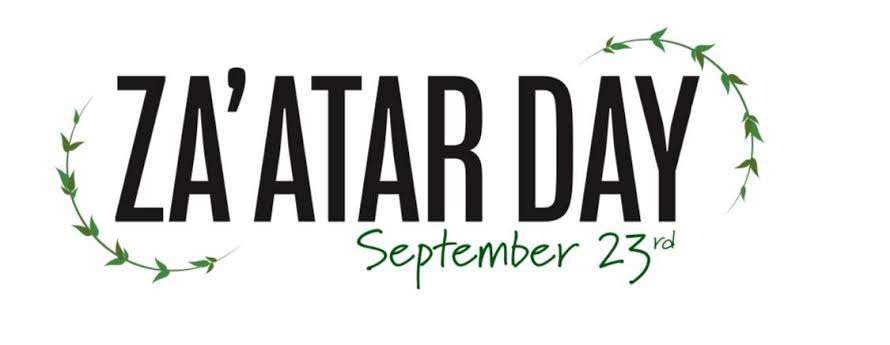Za’atar Day – September 23, 2022, history significance why we celebrate
Za’atar Day, on September 23, is observed as a cultural holiday that celebrates the Za’atar herb which is a staple in most traditional dishes in North Africa and the Middle East. Za’atar is used as a seasoning for meats and vegetables or it can be sprinkled as a seasoning on hummus.
Za’atar is also eaten with labneh, a tangy, creamy cheese made out of yogurt, bread, and olive oil for breakfast. Za’atar features most commonly in Jordan, Palestine, Israel, Syria, and Lebanon, as well as other places in the Arab world. The Lebanese specialty “shanklish,” which is dry-cured balls of labneh, can be rolled in za’atar to form its outer coating.
HISTORY OF ZA’ATAR DAY

In Jewish tradition, Saadiah, Ibn Ezra, Maimonides, and Obadiah ben Abraham all identified the “ezov” mentioned in the Hebrew Bible with the Arabic word ‘za’atar’ which is particularly associated with ritual purity ceremonies, like preparing the ashes of the red heifer.
The Children of Israel are also said to have used some of ezov/za’atar stalks to smear the blood of the Paschal sacrifice on the doorposts of their houses right before leaving Egypt. Za’atar has been used as a staple in Arab cuisine since medieval times and up till the present day, along with other spiced salts. Za’atar has historical significance for Palestinians, some of whom see the presence of za’atar as the symbol of a Palestinian household.
For Palestinian refugees, and other Palestinians in foreign lands, cultural plants and foods such as za’atar are a representation and reminder of the house, village, and region from which they hailed. There is archeological evidence that a za’atar plant was known and used in Ancient Egypt, though its ancient name has not been definitively determined.
Remains of a species used in modern za’atar preparations, known as Thymbra spicata, were found in the tomb of Tutankhamun, and this particular species was known to the Ancient Egyptians as “saem” according to Dioscorides. Ecologists discovered that wild za’atar in Israel was on the verge of extinction due to over-harvesting and in 1977, a law was passed declaring it a protected species.
ZA’ATAR DAY TIMELINE
5th Century B.C.
Za’atar Plants Used in the Passover
It is said that the Israelites in Egyptian captivity use some shrubs of za’atar plants to daub blood on their doorposts during the Paschal sacrifice.
1100s
Za’atar Used as Medicine
Palestinian and some other Arab cultures believe za’atar to be medicinal and use it to this effect.
1977
Za’atar is Declared a Protected Species
Za’atar is declared a protected species in Israel and a fine is attached to the act of harvesting it.
2006
I.D.F. Checkpoints Confiscate Za’atar
Authorities at Israel Defense Forces (I.D.F.) checkpoints begin to confiscate za’atar plants.
RECOMMEND STORIES
- IRCTC’s New Rule: Soon You Can Change Your Travel Date Without Paying a Cancellation Fee
- Dude Movie Review: Pradeep Ranganathan’s Youthful Rom-Com Balances Love, Humor, and cast
- SpaceX Launches 28 Starlink Satellites on Record-Tying 130th Falcon 9 Flight of 2025, Boosting Global Internet Coverage
- 24 Transgender People in Indore Attempt Suicide Seeking Justice, Police Launch Probe and Promise Swift Action
- Cough Syrup 22 Deaths: ED Raids Sresan Pharma Chennai Over Money Laundering Probe
Health Benefits Of Za’atar
Not only does Za’atar taste amazing, but it has a number of health benefits as well. This includes the following…
Strengthen bones – The first health benefit that is associated with Za’atar is that it can help to strengthen your bones. One thing that all of these herbs have in common is minerals. Therefore, between the high concretion of magnesium, copper, calcium, and iron, Za’atar can have a big impact on the density of your bone minerals.
Improve mood – Studies have shown that there are links between Za’atar and decreased rates of depression and heightened mood.
Increase energy – You will also notice that you get a powerful energy boost from Za’atar. It can get your metabolism moving because of the high concentration of flavonoids and polyphenols that are found within the spice mix.
Soothe inflammation – Za’atar can also help to soothe inflammation. You can actually use it as a paste for your skin, rather than consuming it as a food. Putting it on inflamed areas of the skin, such as aching joints and bug bites, can have an effect that is similar to an anti-inflammatory effect.
Clears respiratory tracts – There are a number of expectorant properties of thyme. It can help to clear the respiratory tracts, which will cause you to cough out mucus and phlegm. This makes it an excellent food to add to your diet if you feel a cold coming on.
Relief from chronic disease symptoms – Last but not least, Za’atar acts as an antioxidant, protecting the body against free radicals that are responsible for a number of different health conditions.
How To Make Your Own Za’atar Blend
Of course, the best way to celebrate Za’atar Day is to make your own homemade spice blend. We’ve got a recipe to help you out with this…
Ingredients
- ¼ teaspoon or more of Aleppo chili flakes – it all depends on how much of a kick you like!
- ½ teaspoon kosher salt
- One tablespoon of sumac
- One tablespoon of toasted sesame seeds
- One tablespoon of ground coriander
- One tablespoon of ground cumin
- One tablespoon of dried thyme, which has been crushed
How to make your Za’atar blend
- Grab a small bowl, and mix all of the ingredients together.
- Simply store it in an airtight container.
- For the best flavor, you should toast the whole seeds of coriander and cumin until they are fragrant, and then grind them. However, if you do not have whole seeds, you can simply substitute them for ground spices.
How To Observe Za’atar Day
Aside from making your own Za’atar blend, there are a number of ways that you can observe Za’atar Day. Why not gather your friends and loved ones and cook a meal that contains Za’atar? As mentioned earlier, there are plenty of different ways that you can use this spice blend! It can be present in
everything from the dips you serve to the meat you put on people’s plates. One dish that is easy and is bound to go down a treat is Za’atar roasted chicken. All you need to do is roast the chicken in the manner you usually would, yet cover it with the spice blend so that it is bursting with flavor! Don’t forget to serve some baked Middle Eastern bread with olive oil and Za’atar for the full effect!
Another way to celebrate Za’atar Day is to make your own healthy skin paste. There are so many DIY recipes for skin products on the Internet today, and with the inflammatory properties that are associated with Za’atar, this would certainly make a good ingredient. You are bound to find plenty of different ideas online regarding this, so have fun exploring the different options out there.
In an ode to Za’atar, you could also have fun attempting to create your own spice mix! We are sure you probably have some different herbs and spices in your cupboards, so why not get experimental and see if you can create something as delicious as Za’atar? You never know, you may end up coming up with your own secret mix that everyone wants to know the recipe for!
Sandeep Raiza — Content Writer, Website Designer, SEO Strategist, and WordPress Expert AI specialist delivering impactful digital solutions that drive business growth.Combining creative storytelling with technical expertise.








